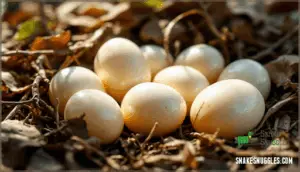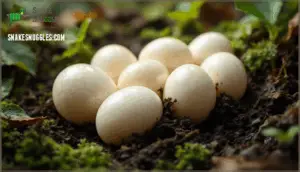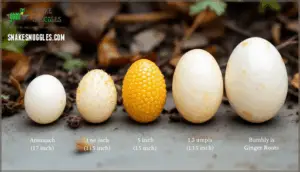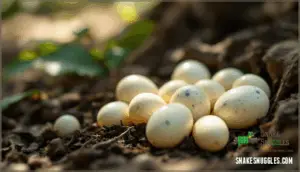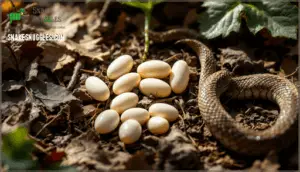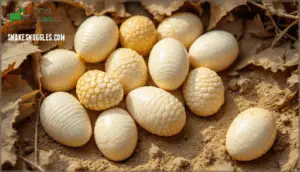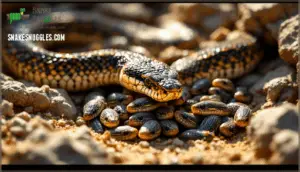This site is supported by our readers. We may earn a commission, at no cost to you, if you purchase through links.

While about 70% of snake species deposit leathery, oblong eggs that incubate externally, rattlesnakes evolved a different approach—their offspring develop entirely within the mother’s body, receiving nutrients and protection until birth.
Understanding this distinction not only clears up the mystery of "rattlesnake eggs" but also reveals fascinating insights into snake reproduction, the characteristics of actual snake eggs, and how to identify them when you encounter them in the wild.
Table Of Contents
- Key Takeaways
- So What Are They? Surely Rattlesnake Eggs, Right?
- Do All Snakes Give Live Birth? What Do Snake Eggs Look Like?
- Can You Eat Snake Eggs?
- Interesting Snake Egg Facts
- Rattlesnake Reproduction: Making More Snakes
- What to Do if You Find a Baby Rattlesnake
- Why Do We Need Rattlesnakes?
- Frequently Asked Questions (FAQs)
- Can you identify a rattlesnake from an egg?
- Do rattlesnakes have eggs?
- How do you identify snake eggs?
- Are Rattlesnake eggs quail eggs?
- What is the difference between snake eggs and chicken eggs?
- How do you know if a snake egg is rotting?
- How Many Species of Snakes Are Oviparous?
- Is it Possible to Tell the Species of a Snake Egg?
- What is the Difference Between Viviparous and Ovoviviparous Snakes?
- How Many Eggs Does a Snake Lay in a Clutch?
- Conclusion
Key Takeaways
- Rattlesnakes don’t lay eggs—they’re viviparous, meaning they give live birth to fully developed young that emerge with functional venom and survival instincts from day one.
- About 70% of snake species do lay soft, leathery eggs that are oblong in shape, white to cream in color, and typically one to three inches long, making them distinguishable from hard-shelled bird eggs.
- Rattlesnakes typically give birth to 5-25 live young between July and September, with no parental care after birth, though first-year mortality rates range from 23% to 47%.
- Rattlesnakes play a critical ecological role by consuming up to 150 rodents annually per snake, providing natural pest control that reduces disease transmission and protects crops while contributing to biodiversity and medical research.
So What Are They? Surely Rattlesnake Eggs, Right?
If you’ve stumbled across mysterious eggs outdoors and wondered whether rattlesnakes left them behind, here’s the truth that might surprise you: rattlesnakes don’t actually lay eggs at all. They’re viviparous, meaning they give live birth to fully developed young.
Rattlesnakes don’t lay eggs—they give live birth to fully formed young, defying the common assumption that all snakes are egg-layers
This misconception about snakes stems from confusion with egg-laying species. Rattlesnake reproduction involves carrying developing embryos internally until birth, when neonates emerge equipped with functional venom and survival instincts.
Unlike oviparous snakes that deposit eggs requiring external incubation, rattlesnake development occurs completely within the mother’s body, eliminating the need for parental care of vulnerable eggs.
Do All Snakes Give Live Birth? What Do Snake Eggs Look Like?
Not every snake gives birth the same way. While rattlesnakes skip the egg-laying step entirely, many other species do lay eggs—and those eggs come with their own set of unique traits.
Let’s look at what snake eggs actually look like and how you can tell them apart from other reptile eggs.
Are Snake Eggs Soft?
When you pick up a snake egg for the first time, you’ll notice it doesn’t feel hard like a chicken egg—it’s surprisingly flexible and leathery. This soft, rubbery shell composition allows for moisture absorption during egg development, which is essential for the embryo’s survival. The leathery texture helps the egg adapt to its environment, preventing dehydration while remaining pliable.
Snake egg identification often starts with this distinctive shell texture—if you can gently indent the surface without cracking it, you’re likely grasping a snake egg. Species variation does exist, with some eggs feeling slightly firmer than others, but all snake eggs share these fundamental leathery soft egg characteristics that distinguish them from bird eggs.
What Do Snake Eggs Look Like?
Once you know what the texture tells you, the visual appearance of snake eggs becomes your next clear identifier. Snake eggs display an elongated, oval egg shape rather than perfectly round forms. Egg coloration ranges from white to off-white or cream, though healthy snake egg characteristics maintain consistent pale tones. The eggshell texture appears smooth yet slightly pebbled under close inspection.
Clutch size varies dramatically by species—some snakes deposit just a few eggs while others lay dozens together. During the incubation period, these eggs often stick together in clusters, making snake egg identification more straightforward when you encounter multiple eggs in damp, protected locations.
How Big Are Snake Eggs?
After understanding texture and appearance, you’ll want to know the actual dimensions—and snake eggs span a surprisingly wide size range depending on the species. Egg size variation runs from approximately one inch to five inches in length, though most fall between one and three inches. Species egg size directly correlates with adult snake dimensions—larger species produce larger eggs.
Snake egg characteristics include an oblong egg shape and size profile. African and Asian species sometimes lay bumpy eggs resembling ginger roots rather than smooth ovals.
Egg size comparison reveals snake eggs consistently exceed most lizard eggs in length and diameter.
How to Identify a Snake Egg
If you’ve stumbled upon a mysterious egg in your yard or garden, you’re probably wondering whether it belongs to a snake—and identifying one isn’t as tricky as you might think. Start by examining the egg texture—snake eggs feel soft and leathery, not hard like bird eggs. The egg shape is usually oblong or oval, stretching longer than it’s wide. Egg color ranges from white to off-white or beige, though discolored eggs showing blue or green indicate mold problems. Egg size varies by species, generally measuring one to three inches in length.
When identifying snake eggs, check the clutch size—snakes often lay multiple eggs together, sometimes 6 to 100 depending on the species. You can also use the candling method by lifting the egg up to a bright light to see if an embryo is developing inside. These snake egg characteristics help you distinguish them from other reptiles’ eggs with reasonable confidence.
Identifying Species of Snake From The Egg
Pinpointing the exact snake species from egg morphology alone presents real identification challenges—overlapping sizes and shapes among species make visual differentiation unreliable without genetic testing. Snake egg characteristics like size (one to five inches) and color offer clues, but species variation complicates things. The eggs are usually white, off-white, or beige, but color can vary across species.
Your best identification tools include observing environmental context, using candling to check embryo development, and noting nearby adult snakes or shed skins for reptile differentiation. Contact local herpetologists for accurate snake species identification when you’re uncertain.
Can You Eat Snake Eggs?
Snake eggs might sound exotic, but are they actually something you’d want to crack into a pan for breakfast? Technically, yes—snake eggs from non-venomous species are edible and consumed in some cultures. However, there are significant toxicity risks and ethical concerns to weigh.
The leathery shell and rubbery texture make preparation methods quite different from chicken eggs. Since venomous snakes produce eggs with no venom inside, egg identification becomes essential for safety. Understanding snake reproduction and snake species helps you avoid potential dangers when encountering these unusual clutches in the wild.
Interesting Snake Egg Facts
Not all snake eggs look like the smooth ovals you might picture—some species produce clutches that resemble wrinkled ginger root or bumpy leather pouches. These oviparous reptiles lay eggs with leathery eggshell texture that feels rubbery to the touch, unlike rigid bird shells. Egg coloration commonly ranges from white to cream, though blue-green tints signal mold and poor egg development.
Clutch size varies dramatically—from six eggs in smaller species to over one hundred in pythons. The incubation period depends on temperature and humidity, with snake reproduction requiring specific conditions for successful hatching.
Snake egg characteristics include permeable membranes that exchange gases throughout development, dispelling misconceptions about snakes being uniform in their reproductive strategies.
Rattlesnake Reproduction: Making More Snakes
Now that you know rattlesnakes don’t lay eggs, you’re probably wondering how they actually reproduce. Understanding their birthing process helps clear up common myths and gives you a better sense of what to expect if you encounter these snakes in the wild.
Let’s look at the key aspects of rattlesnake reproduction, from timing to litter size.
What Time of Year Do Rattlesnakes Give Birth?
Rattlesnakes time their births with the warmth of late summer, usually delivering their young between July and September when conditions give newborns the best shot at survival. The gestation period spans three to five months, during which the female seeks out warm microhabitats to maintain best body temperatures for developing embryos.
This birthing season aligns with peak prey availability and favorable environmental factors that improve newborn survival rates. Regional variations exist—southern populations may give birth earlier, while those in higher elevations or northern rattlesnake habitats might wait until late August.
Because rattlesnakes don’t lay eggs, you won’t find leathery shells during this period. Instead, the female gives live birth to fully formed baby rattlesnakes equipped with functional fangs and venom. Understanding this rattlesnake conduct helps you recognize when encounters with vulnerable newborns are most likely in your area.
How Many Babies Can a Rattlesnake Have at Once?
Litter size varies considerably across rattlesnake species, generally ranging from 5 to 25 live young per birth. Western diamondback rattlesnakes can produce up to 25 neonates, while timber rattlesnakes usually deliver 5 to 20 offspring. Most species average around 8 to 15 babies per litter, placing rattlesnakes in the moderate range for viviparous reptile reproduction.
Species variation isn’t the only factor—maternal age and body size play significant roles. Larger, older females consistently produce bigger broods than their younger counterparts. Environmental factors like prey availability and temperature also influence litter size, with well-fed females in warmer climates often bearing more young.
However, survival rates tell a sobering story. First-year mortality among baby rattlesnakes ranges from 23% to 47%, meaning many newborns won’t reach adulthood despite being born fully equipped with fangs and venom. Timber rattlesnakes are highly venomous snakes, but they’re slow to defend themselves. This combination of moderate litter size and high juvenile mortality explains why rattlesnake populations grow slowly and remain vulnerable to disturbance.
Do Rattlesnakes Stay With Their Eggs?
Since rattlesnakes don’t lay eggs in the first place, the question of whether they stick around to guard a nest doesn’t really apply. These ovoviviparous snakes retain their developing young internally throughout gestation, so there’s no clutch to protect.
Once rattlesnakes give live birth, maternal protection ends almost immediately. Baby rattlesnakes receive zero post-birth care—no feeding, no defense, no guidance. This lack of parental investment might seem harsh, but it’s perfectly suited to rattlesnake conduct and offspring survival strategies.
Neonates emerge fully equipped with functional fangs, venom, and heat-sensing capabilities, making them independent hunters from day one. While some snake species do exhibit maternal protection by coiling around their eggs, rattlesnake reproduction follows a different path entirely. The mother’s investment stops at birth, and the young immediately disperse to begin their solitary lives.
What to Do if You Find a Baby Rattlesnake
Spotting a baby rattlesnake—whether basking on a trail or coiled near your yard—can catch you off guard, especially if you’re unsure how to respond safely. Baby rattlesnakes are venomous from birth, making even small specimens dangerous. Their venom can cause serious injury, so snake encounters require immediate caution.
Here’s what you should do:
- Keep your distance – Back away slowly without sudden movements that might trigger rattlesnake actions
- Don’t attempt safe removal yourself – Contact professional help like animal control or wildlife services
- Watch for additional snakes – Rattlesnakes often birth multiple young in the same area
If a venomous bite occurs, seek emergency first aid immediately. Prevention tips include clearing yard debris and staying alert on trails. Understanding venom dangers helps you respect these animals while protecting yourself during snake encounters and safety situations.
Why Do We Need Rattlesnakes?
After understanding how to approach baby rattlesnake encounters, you might wonder why we tolerate these venomous animals at all. The answer lies in their significant ecological contributions that benefit both wildlife and humans.
Rattlesnakes function as ecosystem engineers, maintaining balance in ways most people overlook. A single rattlesnake consumes up to 150 rodents annually, providing natural pest control that protects crops and reduces economic losses. By controlling rodent populations, they also decrease your risk of diseases like hantavirus and Lyme disease, which these pests carry.
Beyond pest management, rattlesnakes contribute to biodiversity by serving as snake predators that stabilize food webs. They even disperse seeds when prey-ingested seeds pass through their digestive systems and germinate elsewhere—sometimes traveling 8-10 miles from the original source.
Medical advances owe much to rattlesnake venom research. Scientists have developed blood clotting agents and pain relievers from venom compounds, with over 20 unique toxins identified that expand our understanding of protein evolution.
Economic impacts matter too. Rattlesnake harvests support trade in eight U.S. states, and sustainable size restrictions have increased hunter income by 19% while protecting populations. These animals earn their place in our ecosystem.
Frequently Asked Questions (FAQs)
Can you identify a rattlesnake from an egg?
Here’s a surprising fact: roughly 70% of snake species lay eggs, but rattlesnakes aren’t among them. Rattlesnakes don’t lay eggs—they give live birth instead. So, you can’t identify a rattlesnake from an egg.
Do rattlesnakes have eggs?
No, they don’t. Rattlesnakes use viviparity—live birth—instead of laying eggs. This reproductive strategy gives newborn survival advantages, like better protection during development.
While confirmation bias might lead some to assume all snakes lay eggs, rattlesnakes break that pattern entirely.
How do you identify snake eggs?
Look beyond the surface—snake eggs identification hinges on key characteristics. Check egg texture (soft, leathery), egg color (white, off-white, cream), egg shape (elongated, oval), and egg size (usually over an inch).
Clutch size and location provide additional clues for identifying snake eggs.
Are Rattlesnake eggs quail eggs?
No, quail eggs aren’t rattlesnake eggs—rattlesnakes don’t lay eggs at all. This common misconception about snakes stems from egg misidentification. If you’ve spotted small, speckled eggs, they’re likely quail or other bird eggs, not snake-related.
What is the difference between snake eggs and chicken eggs?
Chicken eggs have hard calcium carbonate shells, while snake eggs feature soft, leathery coverings. Yolk size differs too—snake eggs contain proportionally larger yolks.
Incubation needs vary greatly: chicken eggs require warmth and turning, whereas snake eggs absorb environmental moisture through their semi-permeable shells.
How do you know if a snake egg is rotting?
A rotting snake egg shows clear warning signs you can spot through careful observation. Egg discoloration appears as dark patches or unusual spots on the shell surface. The smell test reveals a distinctly foul odor that healthy reptile eggs don’t produce.
Mold growth creates visible fuzzy spots, indicating bacterial contamination. Egg collapse occurs when internal structures break down.
How Many Species of Snakes Are Oviparous?
Think of snake reproduction as a family tree with two main branches—about 70% of the world’s roughly 3,600 snake species follow the oviparous route, laying eggs with leathery shells.
These egg-laying benefits include reduced energy costs for mothers and broader geographic distribution across warmer climates where external incubation thrives.
Is it Possible to Tell the Species of a Snake Egg?
Species identification from snake eggs alone is nearly impossible. Egg size, texture, shell color, and clutch size overlap considerably across snake species.
While geographic location can narrow possibilities, egg characteristics are too similar for reliable species identification without additional context like the nesting site or adult snakes nearby.
What is the Difference Between Viviparous and Ovoviviparous Snakes?
Viviparous snakes nourish their young through a placenta-like connection, delivering fully formed babies. Ovoviviparous snakes retain eggs internally, where embryos develop using yolk reserves before live birth—two distinct reproductive strategies with different nutrient sources and evolutionary advantages.
How Many Eggs Does a Snake Lay in a Clutch?
Snake egg clutch formation varies widely by species, with most snakes laying between 6 and 100 eggs per clutch.
Females deposit their eggs in humid, protected locations where the eggs stick together, forming a tight cluster that helps retain moisture during incubation and improves survival rates.
Conclusion
Think of understanding snake reproduction like peeling back layers of a common myth—each fact reveals something unexpected. Now you know what rattlesnake eggs look like: they simply don’t exist. Rattlesnakes give live birth, keeping their young safe inside until they’re ready to face the world.
While other snake species lay leathery, oblong eggs you might stumble upon outdoors, rattlesnakes evolved differently. This knowledge helps you identify real snake eggs when you find them and appreciate the fascinating diversity in how snakes bring new life into existence.
- https://www.fs.usda.gov/database/feis/animals/reptile/crho/all.html
- https://open.alberta.ca/dataset/25189195-d2ac-49c5-85d8-eaeaea9f1e45/resource/3aaa1202-0ae6-4f94-b7a2-557aae0c52cb/download/2007-sar103-reproductivebiologyfemaleprairierattlesnakes-mar2007.pdf
- https://www.reddit.com/r/snakes/comments/1d3ywy1/rattlesnake_and_eggs_in_my_backyard_tucson_az_any/
- https://a-z-animals.com/animals/snake/snake-facts/snake-eggs/
- https://www.michepestcontrol.com/blog/2023/september/what-do-snake-eggs-look-like-/

